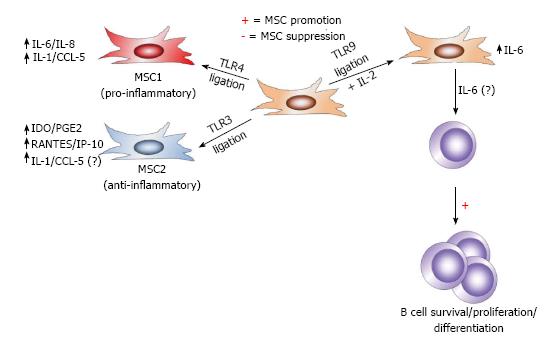Copyright
©2014 Baishideng Publishing Group Inc.
World J Stem Cells. Nov 26, 2014; 6(5): 526-539
Published online Nov 26, 2014. doi: 10.4252/wjsc.v6.i5.526
Published online Nov 26, 2014. doi: 10.4252/wjsc.v6.i5.526
Figure 5 Differential toll-like receptor stimulation affects mesenchymal stem cell immune-modulation.
Mesenchymal stem cells (MSCs) are situated throughout the body as sentinels in virtually all organs and the perivasculature and are equipped with pattern-recognition receptors, including Toll-like receptorS (TLRS), to detect DAMPs from dying cells and PAMPs from pathogens. In response to TLR3 signaling, MSCs maintain an anti-inflammatory MSC2 phenotype, marked by induction of IDO, PGE2, RANTES, and IP-10 (in addition to IL-1 and CCL-5). However, in response to signaling through TLR3, MSC adopt the pro-inflammatory MSC1 phenotype and up-regulate IL-6 and IL-8, in addition to IL-1 and CCL-5. In the presence of IL-2 in combination with TLR9 signaling, MSCs have been shown to also produce IL-6, which promotes B cells survival, proliferation, and differentiation, though MSC-derived IL-6 has not been demonstrated to directly exert these effects on B cells.
- Citation: Glenn JD, Whartenby KA. Mesenchymal stem cells: Emerging mechanisms of immunomodulation and therapy. World J Stem Cells 2014; 6(5): 526-539
- URL: https://www.wjgnet.com/1948-0210/full/v6/i5/526.htm
- DOI: https://dx.doi.org/10.4252/wjsc.v6.i5.526









